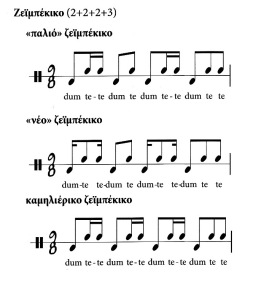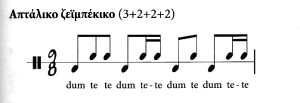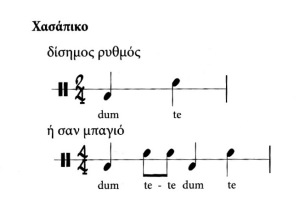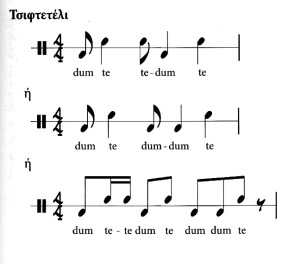The two most common rhythms in rebetika are the compound 9/8 zeïbekiko and the 2/4 hasapiko. The 4/4 tsifteteli is also reasonably common. These are all dance rhythms, tied to specific dances. The zeïbekiko is an improvisational, solo male dance; the hasapiko is danced by two, three or more people with a variety of synchronous steps and movements; and the tsifteteli is the belly dance and it’s also used for amanedes.
The zeïbekiko rhythm, in particular, seems to have been unique to the western coast of Turkey and the Greek islands nearby (e.g., Lesvos). It’s not found in Greek or Turkish folk music outside this region. This rhythm is really the backbone of rebetika–the one which gives the music much of its character. It became a mainstay in Greek music only after the population exchange between Greece and Turkey in 1922-23.
Here are the rhythms (in order):
The compound zeïbekiko rhythm can be divided in numerous ways (illustrated below). The various zeïbekika: old zeïbekiko, new zeïbekiko, kamilieriko zeïbekiko, aptaliko zeïbekiko:
The hasapiko:
Tsifteteli:
Some song examples:
Kostas Bezos, Paximadokleftra (Old Zeïbekiko)
Markos Vamvakaris, Ta Duo sou Heria Pirane (Aptaliko Zeibekiko)
Markos Vamvakaris, Ta Matoklada sou Lamboun (Kamilieriko Zeibekiko)
Markos Vamvakaris, Kapote Imouna ki Ego (Hasapiko)
Dimitris Semsis, Diplohordo Tsifteteli (Tsifteteli)
Roza Eskenazi, Amanes Ousak (Tsifteli – Amanes)




